一、@Autowired是什么
(1)存在范围
@Autowired注解是属于spring的容器配置的一个注解,因此@Autowired注解是一个用于Spring容器配置的注解。与它同属容器配置的注解还有:
@Primary(含义:首选项,当类型冲突情况下,此注解修饰类作为首选注入
位置:修饰类
注意:不能单独使用),
@Qualifier(value="注入的id")
含义:按照名称装配
位置:修饰成员变量
注意:不能单独使用
@Resource(name="注入的id")
含义:按照名称装配
位置:修饰成员变量
注意:单独使用......等等。
(2)定义解释
@Autowired注解又称:自动装配。在Spring中,自动装配指的就是使用将Spring容器中的bean自动的和我们需要这个bean的类组装在一起。
二、什么情况下使用到@Autowired
前情回顾:使用spring开发时,进行配置Spring bean元数据主要有三种方式。
一:基于 XML 配置
二:基于 注解 配置:Spring2.5以上版本支持
三:基于Java 配置:Spring3.0以上版本支持
基于注解配置时,完成自动化装配Bean的情况下,@Autowired的使用便会使Spring自动满足bean之间的依赖注入。
三、如何使用@Autowired
(1)使用位置:修饰成员变量
@Controller
public class StudentControllerImp implements IStudentController {
@Autowired
private IStudentService service;
@Override
public void save() {
System.out.println("======controler的新增方法=======");
service.save();
}
}
(2)在xml文件中完成组件扫描设置
<!--扫描包-->
<context:component-scan base-package="com.apesource"></context:component-scan>
com.apesource---包名;启用组件扫描,默认当前配置类所在包为基础包
四、@Autowired注解是如何实现的
--------------------------------以下部分内容参考于相关公众号文章-----------------------------------------------
(1)打开@Autowired源码
package org.springframework.beans.factory.annotation;
import java.lang.annotation.Documented;
import java.lang.annotation.ElementType;
import java.lang.annotation.Retention;
import java.lang.annotation.RetentionPolicy;
import java.lang.annotation.Target;
@Target({ElementType.CONSTRUCTOR, ElementType.METHOD, ElementType.PARAMETER, ElementType.FIELD, ElementType.ANNOTATION_TYPE})
@Retention(RetentionPolicy.RUNTIME)
@Documented
public @interface Autowired {
boolean required() default true;
}
我们知道: 在java中注解实现的核心技术是反射
(2)我们让看一下源代码中的元注解(也就是上面提到的注解的注解),总共有4个如下:
@Target,说明的是Annotation所修饰的对象范围
@Retention,定义了该Annotation被保留的时间长短:使用这个元注解可以对 Annotation的“生命周期”限制
@Documented,用于描述其它类型的annotation应该被作为被标注的程序成员的公共API,因此可以被例如javadoc此类的工具文档化。Documented是一个标记注解,没有成员
@Inherited;元注解是一个标记注解,@Inherited阐述了某个被标注的类型是被继承的。如果一个使用了@Inherited修饰的annotation类型被用于一个class,则这个annotation将被用于该class的子类
Autowired注解可以应用在构造方法,普通方法,参数,字段,以及注解这五种类型的地方,它的保留策略是在运行时。
(3)在Spring源代码当中,Autowired注解位于包org.springframework.beans.factory.annotation之中,该包的内容如下:
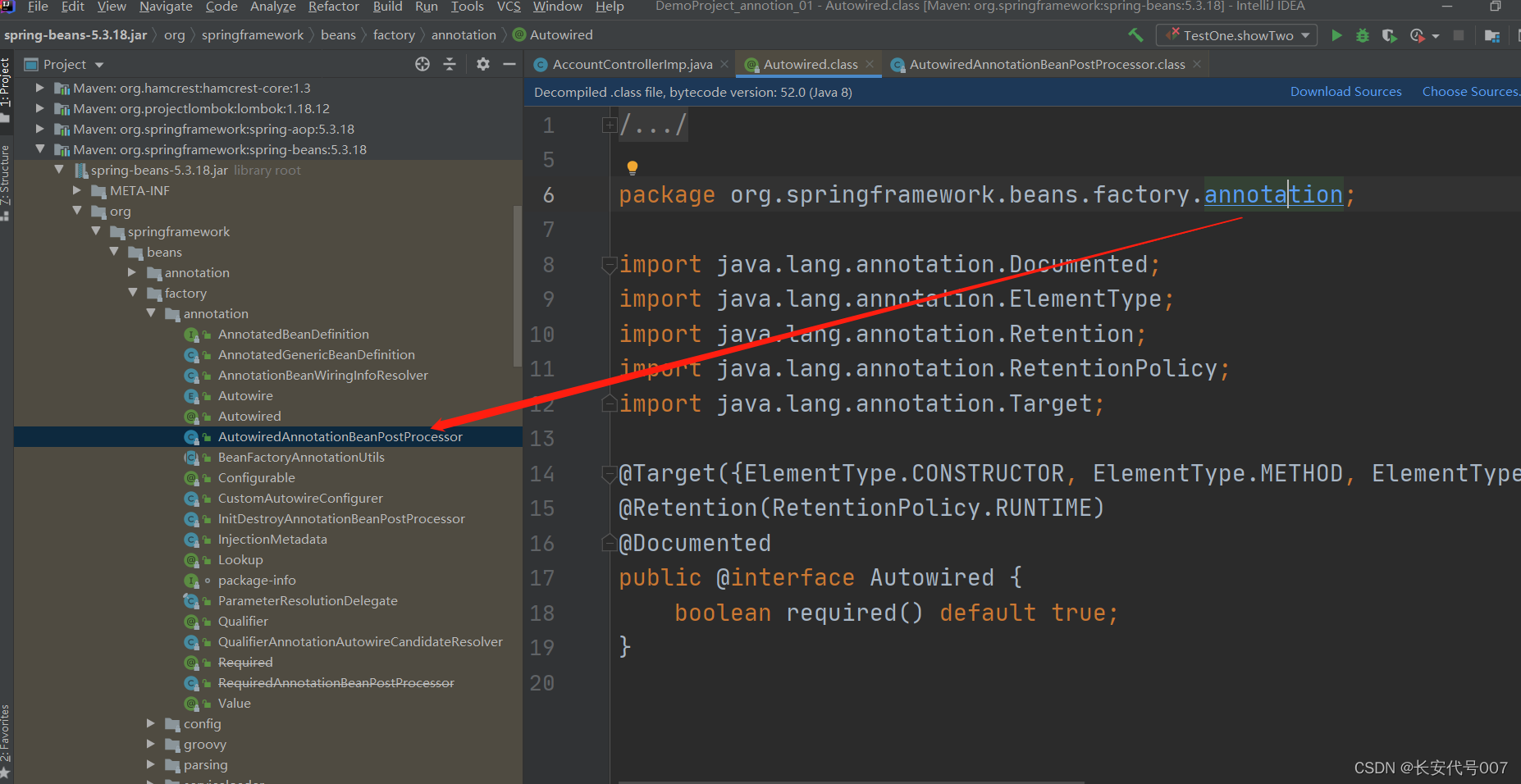
Spring对autowire注解的实现逻辑位于类:AutowiredAnnotationBeanPostProcessor之中,红色箭头所指的类。其中的核心处理代码如下:
private InjectionMetadata buildAutowiringMetadata(Class<?> clazz) {
if (!AnnotationUtils.isCandidateClass(clazz, this.autowiredAnnotationTypes)) {
return InjectionMetadata.EMPTY;
}
List<InjectionMetadata.InjectedElement> elements = new ArrayList<>();
Class<?> targetClass = clazz; //需要处理的目标类
do {
final List<InjectionMetadata.InjectedElement> currElements = new ArrayList<>();
//通过反射获取该类所有的字段,并遍历每一个字段,并通过方法findAutowiredAnnotation遍历每一个字段的所用注解,并如果用autowired修饰了,则返回auotowired相关属性
ReflectionUtils.doWithLocalFields(targetClass, field -> {
MergedAnnotation<?> ann = findAutowiredAnnotation(field);
if (ann != null) {校验autowired注解是否用在了static方法上
if (Modifier.isStatic(field.getModifiers())) {
if (logger.isInfoEnabled()) {
logger.info("Autowired annotation is not supported on static fields: " + field);
}
return;
//判断是否指定了required
}
boolean required = determineRequiredStatus(ann);
currElements.add(new AutowiredFieldElement(field, required));
}
});
//和上面一样的逻辑,但是是通过反射处理类的method
ReflectionUtils.doWithLocalMethods(targetClass, method -> {
Method bridgedMethod = BridgeMethodResolver.findBridgedMethod(method);
if (!BridgeMethodResolver.isVisibilityBridgeMethodPair(method, bridgedMethod)) {
return;
}
MergedAnnotation<?> ann = findAutowiredAnnotation(bridgedMethod);
if (ann != null && method.equals(ClassUtils.getMostSpecificMethod(method, clazz))) {
if (Modifier.isStatic(method.getModifiers())) {
if (logger.isInfoEnabled()) {
logger.info("Autowired annotation is not supported on static methods: " + method);
}
return;
}
if (method.getParameterCount() == 0) {
if (logger.isInfoEnabled()) {
logger.info("Autowired annotation should only be used on methods with parameters: " +
method);
}
}
boolean required = determineRequiredStatus(ann);
PropertyDescriptor pd = BeanUtils.findPropertyForMethod(bridgedMethod, clazz);
currElements.add(new AutowiredMethodElement(method, required, pd));
}
});
//用@Autowired修饰的注解可能不止一个,因此都加在currElements这个容器里面,一起处理
elements.addAll(0, currElements);
targetClass = targetClass.getSuperclass();
}
while (targetClass != null && targetClass != Object.class);
return InjectionMetadata.forElements(elements, clazz);
}最后这个方法返回的是一个InjectionMetadata集合。由两部分组成:
一是我们处理的目标类,二就是上述方法获取到的所以elements集合。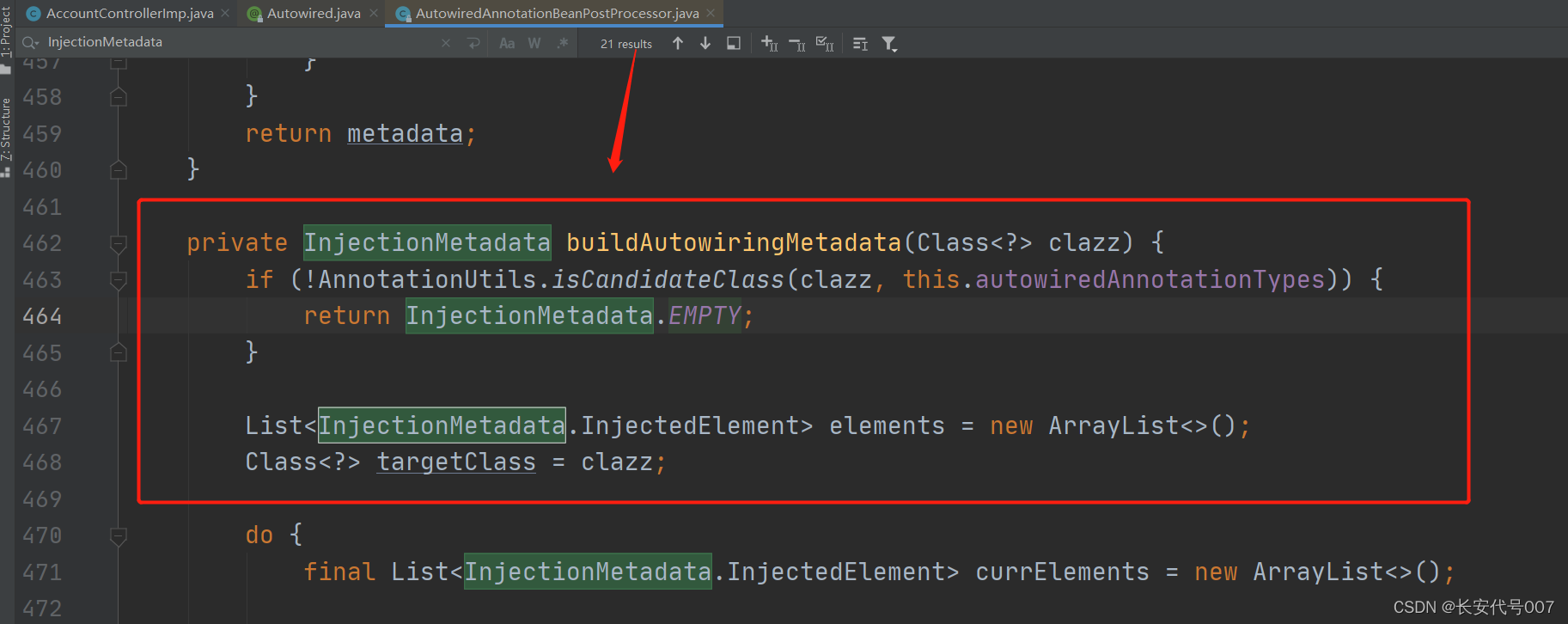
源代码:
private InjectionMetadata buildAutowiringMetadata(Class<?> clazz) {
if (!AnnotationUtils.isCandidateClass(clazz, this.autowiredAnnotationTypes)) {
return InjectionMetadata.EMPTY;
}
List<InjectionMetadata.InjectedElement> elements = new ArrayList<>();
Class<?> targetClass = clazz;有了目标类,与所有需要注入的元素集合之后,我们就可以实现autowired的依赖注入逻辑了,实现的方法如下:
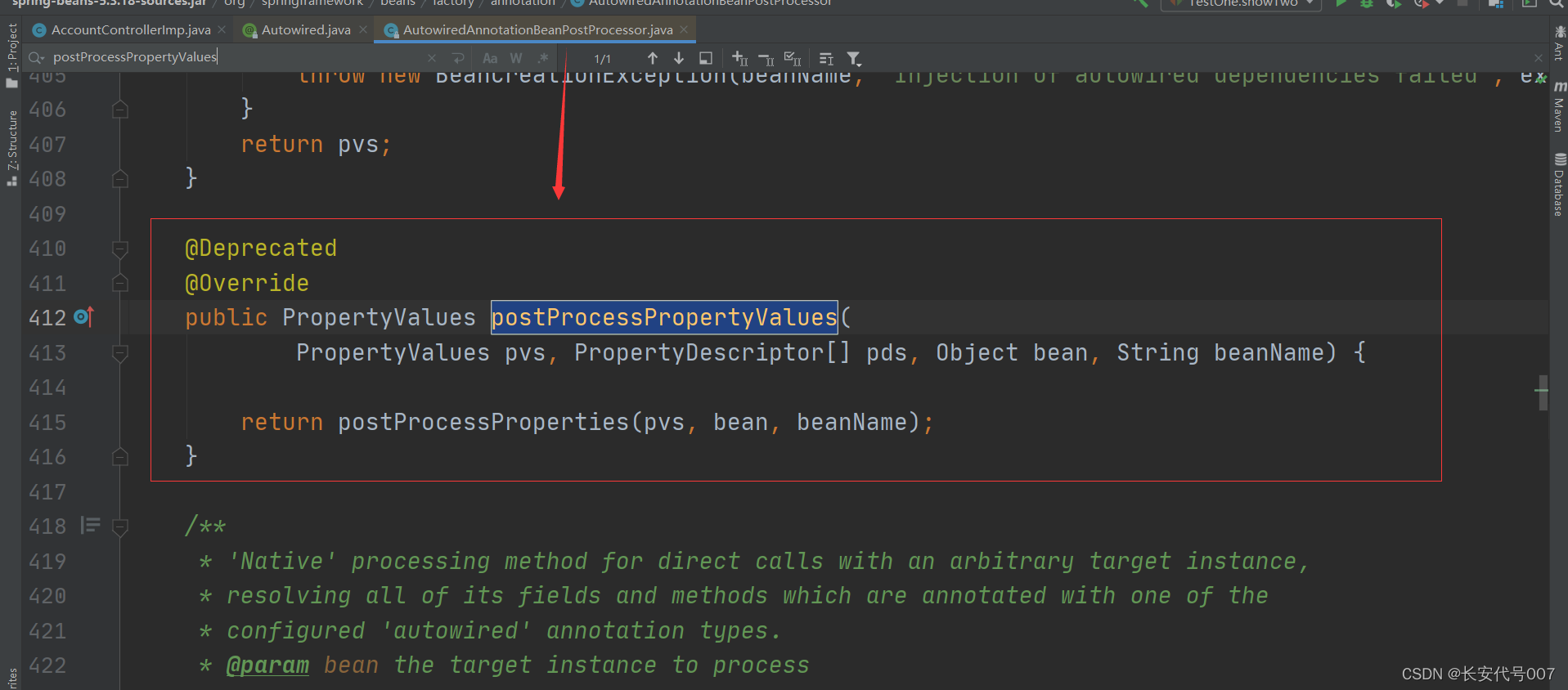
源代码:
@Deprecated
@Override
public PropertyValues postProcessPropertyValues(
PropertyValues pvs, PropertyDescriptor[] pds, Object bean, String beanName) {
return postProcessProperties(pvs, bean, beanName);
}它调用的方法是InjectionMetadata中定义的inject方法,如下
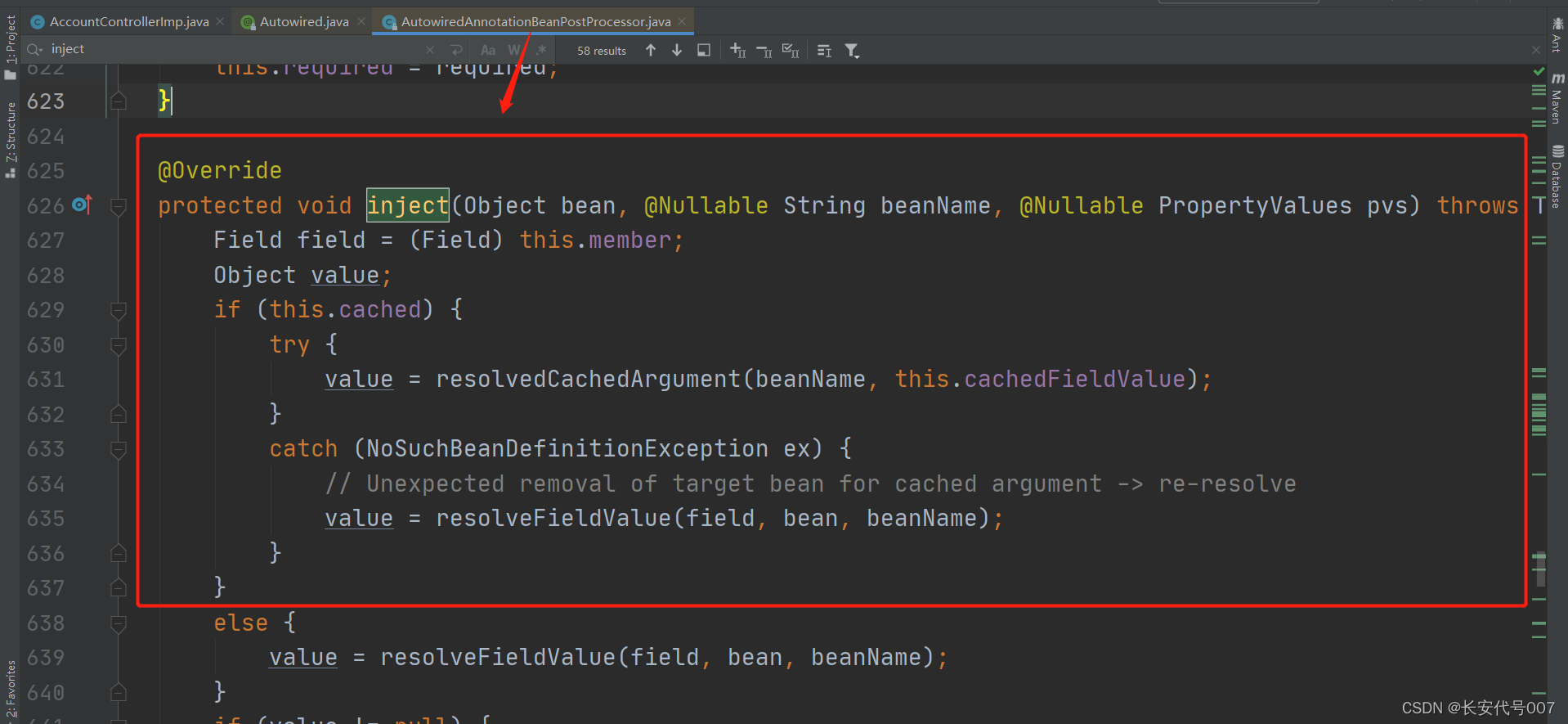
源代码
@Override
protected void inject(Object bean, @Nullable String beanName, @Nullable PropertyValues pvs) throws Throwable {
Field field = (Field) this.member;
Object value;
if (this.cached) {
try {
value = resolvedCachedArgument(beanName, this.cachedFieldValue);
}
catch (NoSuchBeanDefinitionException ex) {
// Unexpected removal of target bean for cached argument -> re-resolve
value = resolveFieldValue(field, bean, beanName);
}
}
else {
value = resolveFieldValue(field, bean, beanName);
}
if (value != null) {
ReflectionUtils.makeAccessible(field);
field.set(bean, value);
}
}然后调用inject方法;
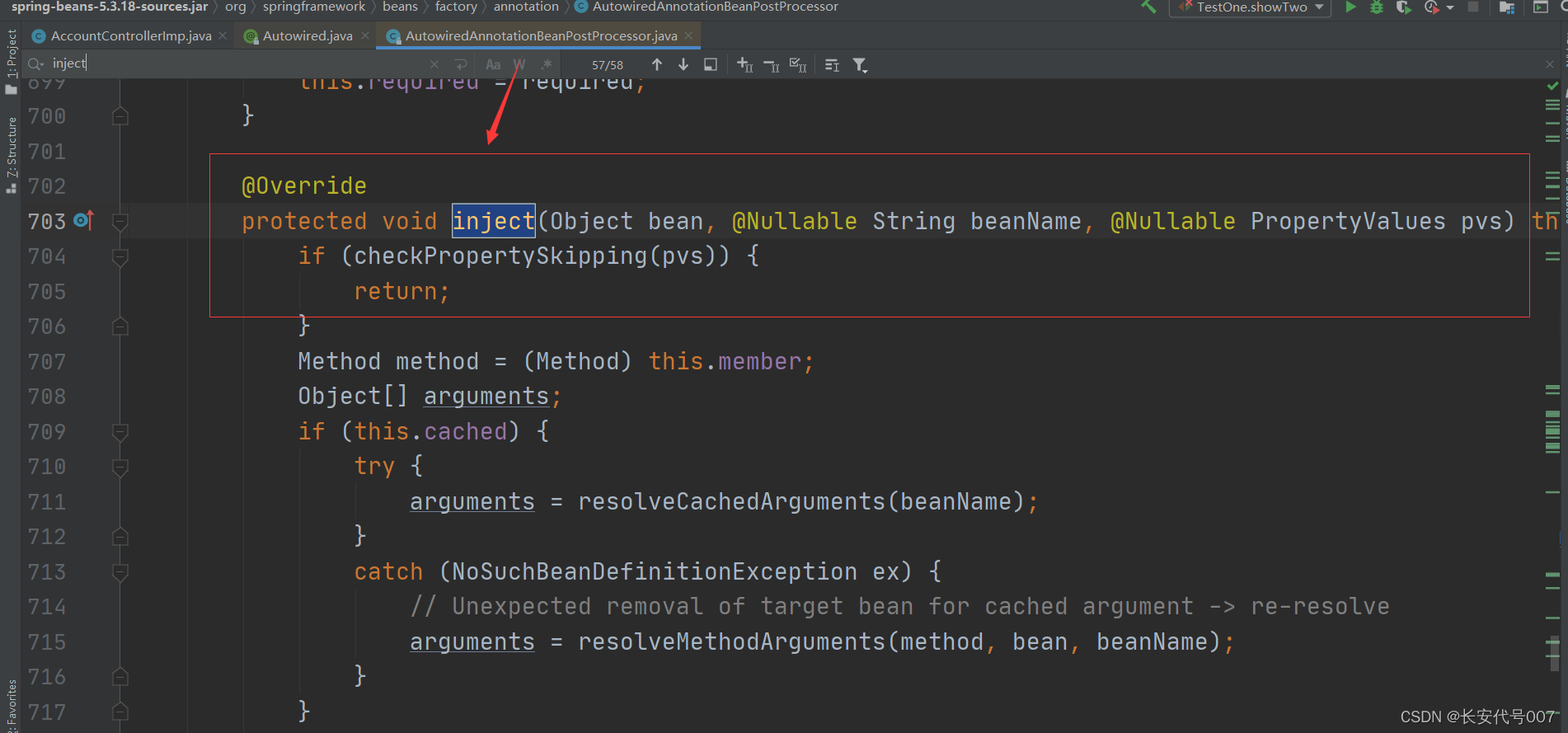
源代码
@Override
protected void inject(Object bean, @Nullable String beanName, @Nullable PropertyValues pvs) throws Throwable {
if (checkPropertySkipping(pvs)) {
return;
}
Method method = (Method) this.member;
Object[] arguments;
if (this.cached) {
try {
arguments = resolveCachedArguments(beanName);
}
catch (NoSuchBeanDefinitionException ex) {
// Unexpected removal of target bean for cached argument -> re-resolve
arguments = resolveMethodArguments(method, bean, beanName);
}
}
else {
arguments = resolveMethodArguments(method, bean, beanName);
}
if (arguments != null) {
try {
ReflectionUtils.makeAccessible(method);
method.invoke(bean, arguments);
}
catch (InvocationTargetException ex) {
throw ex.getTargetException();
}
}
}在这里的代码当中我们也可以看到,是inject也使用了反射技术并且依然是分成字段和方法去处理的。在代码里面也调用了makeAccessible这样的可以称之为暴力破解的方法,但是反射技术本就是为框架等用途设计的。
对于方法的话,本质就是去调用这个方法,因此这里调用的是method.invoke.
getResourceToInject方法的参数就是要注入的bean的名字,这个方法的功能就是根据这个bean的名字去拿到它。
总结:
使用@Autowired注入的bean对于目标类来说,从代码结构上来讲也就是一个普通的成员变量,@Autowired和spring一起工作,通过反射为这个成员变量赋值,将其变为实例对象。